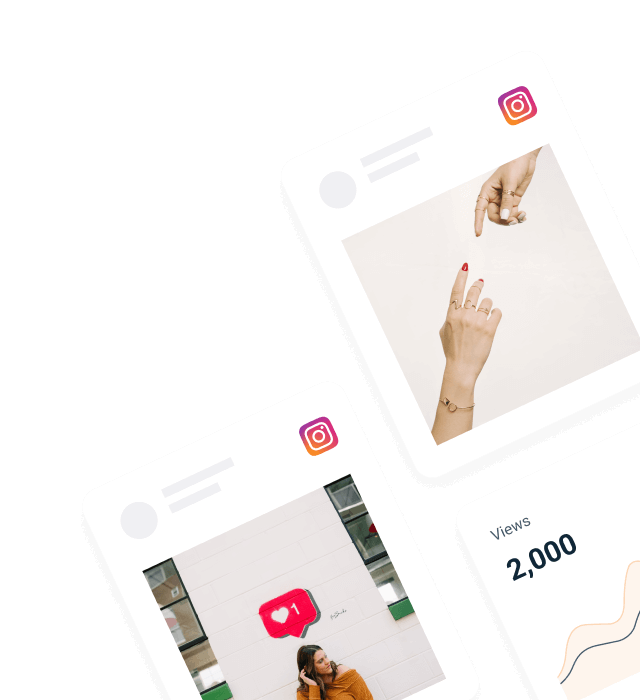Instagram’s API allows 200 requests per hour. X.com (Twitter) limits free accounts to 1,500 requests per month. TikTok requires business verification that takes weeks to approve.
If those sentences give you a headache, you’ve come to the right place. Because these constraints can become problems fast when you’re trying to pull content from multiple social media platforms into a single feed. What looks like a simple “show our social posts on the website” project turns into a technical challenge that breaks more often than it works.
Multi-platform social media integration works—when it’s built to handle the reality of API limitations, content formatting differences, and moderation requirements that most teams don’t anticipate upfront.
Why Multi-Platform Integration Beats Single-Channel Social Feeds
Most brands treat social media integration like a nice-to-have feature. They’re wrong. When done strategically, combining multiple social media platforms into unified displays creates marketing leverage that single-channel approaches simply can’t match.
Different platforms produce different types of social proof.
Instagram gives you visual product demonstrations and lifestyle content. LinkedIn provides professional testimonials and industry credibility. TikTok delivers authentic product reviews and creative usage ideas. Twitter offers real-time customer service interactions and brand personality.
Each platform serves your target audience differently. Trying to force all your social media content into one platform diminishes the unique value each channel provides.

Unified social feeds create comprehensive brand storytelling.
When website visitors see content from various social media platforms displayed together, they get a complete picture of your brand’s social media presence. This builds stronger customer loyalty than isolated feeds from single platforms.
The psychological impact matters more than most marketers realize. People trust brands that feel active and engaged across multiple channels. A social media aggregator that combines platforms creates the impression of sustained, authentic activity—even when your actual posting frequency is modest.
Technical efficiency scales your marketing efforts.
Managing content across multiple platforms manually doesn’t scale. Smart social media integration strategies automate content curation, reduce duplicate effort, and let your marketing team focus on creation instead of distribution.
The operational advantage compounds over time. Instead of updating five different social feeds, you manage one integration strategy that pulls relevant content automatically and displays it where conversions happen.
“The brands winning with social media integration aren’t posting more—they’re showcasing their existing content more strategically. They understand that aggregated data from multiple platforms tells a better brand story than any single-channel approach.”
The Technical Reality: Why Most Integration Projects Fail
Building custom social media integration sounds straightforward until you hit the technical limitations. Here’s what actually happens when teams try to combine multiple social media platforms without understanding the constraints.
API rate limits kill real-time updates.
Each social platform has different API restrictions. Instagram allows 200 requests per hour per user. Twitter’s free tier limits you to 1,500 tweets per month. TikTok’s API access requires business verification that takes weeks to approve.
When you’re pulling content from multiple platforms simultaneously, you hit these limits fast. Your “real-time” social feed becomes a static display that updates sporadically—exactly the opposite of what social proof is supposed to achieve.
Smart integration strategy means implementing intelligent caching that refreshes content at optimal intervals without exceeding platform limits. This requires understanding each platform’s specific restrictions and building refresh schedules that maintain freshness while staying within technical boundaries.
Content formatting inconsistencies break user experience.
Instagram posts are square. TikTok videos are vertical. Twitter posts are text-heavy with occasional images. LinkedIn content includes professional context that doesn’t make sense on product pages.
When you aggregate content from various social media platforms without considering format differences, you create visual chaos that hurts your brand’s credibility instead of helping it.
Effective social media content aggregator tools normalize formatting while preserving the authentic feel that makes social proof compelling. This means responsive design that adapts to different content types without forcing everything into identical templates.
Moderation becomes unmanageable at scale.
User-generated content from multiple channels creates moderation challenges that single-platform feeds don’t face. What’s appropriate on TikTok might not work on your homepage. Professional LinkedIn content might be too formal for product pages targeting younger demographics.
Without systematic content curation processes, multi-platform integration becomes a liability. Inappropriate content, negative reviews, or off-brand messaging can appear on your website automatically, damaging customer experiences instead of improving them.
The solution involves building moderation workflows that filter content based on platform, content type, keyword triggers, and brand alignment before anything goes live on your website.
Data inconsistencies complicate analytics.
Different social media platforms provide different engagement metrics, timestamp formats, and user data structures. Combining this aggregated data into meaningful insights requires normalization that most marketing teams aren’t equipped to handle.
When your integration strategy doesn’t account for these differences, you end up with analytics that look comprehensive but provide limited actionable insights for optimizing your social media strategy.
DIY Integration vs. Third-Party Tools: The Real Trade-Offs
The build-versus-buy decision for social media integration isn’t just about budget—it’s about ongoing maintenance, technical complexity, and strategic focus.
Building Custom Integration In-House
The appeal is obvious: complete control over functionality, unlimited customization, and no monthly subscription fees.
The reality is different: API changes from social platforms break your integration without warning. Instagram updates its API structure, and suddenly, your carefully built system stops pulling posts. Twitter changes authentication requirements, and your real-time feed goes dark.
Custom development requires ongoing maintenance that most marketing teams underestimate. You’re not just building the initial integration—you’re committing to monitoring multiple platform APIs, updating authentication tokens, handling error states, and maintaining server infrastructure.
For companies with dedicated development resources and specific technical requirements that existing tools can’t meet, custom solutions make sense. But the total cost of ownership typically exceeds third-party alternatives when you factor in ongoing maintenance, platform updates, and feature development.
Using Social Media Aggregator Tools
Third-party solutions handle the technical complexity so your marketing team can focus on content strategy instead of API management.
Quality social media integration tools maintain relationships with platform providers, update their systems when APIs change, and provide customer support when things break. This operational advantage becomes more valuable over time as platform requirements become more complex.
The trade-off is customization flexibility. Most SaaS tools offer standard features that work for common use cases but may not support highly specific requirements or unique branding needs.
However, the best social media content aggregator platforms provide enough customization options to match most brand requirements without the ongoing maintenance burden of custom development.
Cost comparison favors third-party tools when you calculate total ownership expenses. Custom development might seem cheaper initially, but ongoing maintenance, server costs, and developer time typically exceed subscription fees within 12-18 months.
How Juicer Solves Multi-Platform Integration Challenges
Rather than forcing you to choose between technical complexity and strategic impact, Juicer handles the integration challenges while giving you control over content strategy and brand presentation.

Simplified Multi-Platform Connection
Juicer connects to 15+ social media platforms through a single dashboard that doesn’t require technical setup. Connect Instagram, TikTok, Twitter, LinkedIn, Facebook, YouTube, and other channels using OAuth authentication that takes minutes, not weeks.
The platform handles API rate limits automatically by implementing intelligent refresh schedules that maintain content freshness while staying within platform restrictions. No more broken feeds when you hit usage limits.
Content from various social media platforms gets normalized into consistent formats that work across different website contexts—product pages, homepages, event displays—without requiring separate integration for each use case.
Advanced Content Curation Without Manual Management
Smart filtering lets you curate content based on hashtags, keywords, user accounts, or platform types without manually approving every post. Set rules once, then let the system automatically display relevant content that matches your brand standards.
Moderation tools provide multiple layers of content quality control: automatic spam filtering, keyword-based exclusion rules, and manual approval workflows for sensitive brand contexts.
This approach scales content curation across multiple channels while maintaining brand consistency. Your marketing team sets strategic parameters, and Juicer handles the operational details of content aggregation and display.

Flexible Display Options for Different Marketing Goals
Whether you need social proof for product pages, event displays for conferences, or homepage engagement features, Juicer provides customizable templates that match your specific marketing strategy needs.
The platform works with any website CMS through simple embed codes that don’t require developer involvement. WordPress, Shopify, Webflow, custom sites—the integration process stays consistent regardless of your technical infrastructure.
Advanced features like custom CSS, white-label branding, and API access provide expansion options for teams with specific technical requirements while maintaining the ease-of-use that makes social media integration practical for marketing teams.
Analytics That Actually Inform Strategy
Instead of vanity metrics from individual platforms, Juicer provides consolidated analytics that show how social media integration affects website engagement, conversion rates, and customer behavior patterns.
Track which types of content from which social platforms drive the most engagement on specific website pages. This data helps optimize your content strategy across channels instead of guessing which social media posts will resonate with website visitors.
Integration with marketing automation platforms and CRM systems connects social engagement data with broader customer journey analytics, providing actionable insights for improving both social media strategy and website conversion rates.
“The difference between social media integration that looks impressive and integration that drives results comes down to strategic implementation. It’s not about displaying all your content everywhere—it’s about showing the right content to the right people at the right moments in their decision process.”
Strategic Implementation: Making Integration Work for Your Goals
Effective social media integration requires more than technical setup. It demands strategic thinking about how social proof supports your broader marketing objectives.
Content Strategy Across Multiple Platforms
Different social media platforms serve different functions in customer decision-making. Instagram posts work well for visual product demonstration. LinkedIn content builds professional credibility. Twitter interactions show customer service responsiveness.
Map your social content to customer journey stages instead of treating all platforms equally. Early-stage prospects need social proof that builds awareness and credibility. Late-stage prospects need specific product validation and purchase confidence.
Your integration strategy should prioritize relevant content for each website context. Product pages benefit from user generated content showing real product usage. About pages work better with professional testimonials and company culture content from LinkedIn.
Audience Segmentation Through Platform Context
Social media platforms attract different demographic segments and behavioral patterns. TikTok users engage with different content styles than LinkedIn users. Instagram audiences have different expectations than Twitter followers.
Smart social media integration leverages these differences instead of homogenizing content across platforms. Display TikTok content on pages targeting younger demographics. Use LinkedIn testimonials for B2B decision-makers evaluating professional services.
This targeted approach increases the effectiveness of social proof by showing potential customers content from people who match their demographic profile and decision-making context.
Performance Optimization Through Testing
Social media integration should be measurable and improvable. Test different content types, placement strategies, and platform combinations to identify what drives the best results for your specific audience and business goals.
A/B testing different social feed configurations helps optimize for specific metrics: engagement rates, time on page, conversion rates, or lead generation, depending on your marketing priorities.
Use analytics data to refine your content curation rules, adjust platform priorities, and improve the alignment between social media presence and business outcomes.
Industry-Specific Integration Strategies
Social media integration works differently depending on your industry, target audience, and business model. Here’s how to adapt multi-platform strategies for maximum impact.
E-commerce: Building Purchase Confidence
E-commerce sites benefit most from user-generated content that demonstrates product usage, reviews that address common concerns, and social proof that builds purchase confidence.
Instagram posts showing products being used in real contexts convert better than professional product photography because they bridge the gap between marketing images and actual customer experience.
Integrate review content from Google, Facebook, and industry-specific platforms to provide comprehensive social proof that addresses different customer concerns at different stages of the buying process.
B2B Services: Demonstrating Professional Credibility
Professional services need social media integration that builds trust and demonstrates expertise. LinkedIn testimonials, case study mentions, and professional recognition work better than casual social media posts.
Content strategy should prioritize thought leadership content, client testimonials, and industry recognition over lifestyle or entertainment content that works for B2C brands.
Integration on contact forms, service pages, and about pages helps prospects evaluate professional competence before initiating business relationships.
Events and Conferences: Creating Community Engagement
Event-based businesses need real-time social media integration that builds excitement, demonstrates community engagement, and encourages participation.
Live hashtag campaigns, attendee posts, and speaker content create FOMO effects that drive registration and attendance while building brand awareness in relevant professional communities.
Digital displays showing social media content during events create engagement loops where attendees participate in social campaigns that generate content for future marketing efforts.
Measuring Success: Metrics That Matter for Social Integration
Tracking the right metrics helps optimize social media integration for business results instead of vanity numbers that don’t connect to revenue.
Website Engagement Metrics
Monitor how social media integration affects overall website performance: time on page, pages per session, bounce rate, and conversion rates on pages with social feeds versus pages without.
These metrics show whether social proof is actually improving user experience or just adding visual elements that don’t drive business outcomes.
Compare engagement patterns between different types of social content to identify which platforms and content types resonate most with your website audience.
Conversion Attribution
Track conversions that occur after interaction with social media integration elements. This includes newsletter signups, contact form submissions, product purchases, and other business-relevant actions.
Advanced analytics platforms can attribute conversions to specific social media posts or platforms, helping optimize content curation strategies for maximum business impact.
Understanding which social proof elements drive the most valuable customer actions helps prioritize platform integration and content types.
Customer Journey Analytics
Analyze how social media integration affects broader customer journey metrics: lead quality, sales cycle length, customer lifetime value, and retention rates.
Customers who engage with social proof during their research process often convert faster and show higher satisfaction rates because they enter purchase decisions with realistic expectations set by authentic customer content.
This data helps justify social media integration investments by connecting social proof efforts to long-term business value.
Take Action: Start With Strategic Social Integration
Your social media content is already out there. The question is whether you’re using it strategically to drive business results or letting it sit unused while potential customers make decisions without social proof.
Multi-platform social media integration isn’t about displaying more content—it’s about displaying the right content in the right places to support customer decision-making and build authentic brand credibility.
The technical challenges are solvable. The strategic implementation is learnable. The business impact is measurable.
Ready to turn scattered social content into conversion-focused social proof? Try Juicer free for 14 days and see how multi-platform integration changes your website engagement and conversion rates.
Frequently Asked Questions
What’s the minimum number of social media platforms needed for effective integration?
Three platforms typically provide enough content variety and social proof without overwhelming visitors. Focus on the platforms where your target audience is most active and where you consistently produce quality content. A successful integration strategy prioritizes relevance over quantity.
How do you handle different content formats across platforms without breaking website design?
Quality social media integration tools automatically normalize content formatting while preserving authenticity. This means responsive layouts that adapt to different content types, consistent sizing for images and videos, and typography that matches your website design while maintaining the natural feel of social media posts.
What are the most common technical issues when combining multiple social feeds?
API rate limits cause the most problems, followed by authentication token expiration and inconsistent data formats. Professional social media aggregator tools handle these issues automatically by implementing smart refresh schedules, maintaining platform relationships, and normalizing data structures across different social media platforms.
How do you moderate content quality across multiple platforms without constant manual oversight?
Set up automated filtering based on keywords, hashtags, user accounts, and content types. Use whitelist approaches for highly sensitive brand contexts and blacklist approaches for general content curation. Most quality issues can be prevented through strategic filtering rules rather than manual review of every post.
Does social media integration slow down website performance?
When implemented correctly, social media integration should have minimal impact on page load speeds. Use lazy loading for social content, optimize image sizes automatically, and choose tools that cache content efficiently. Poor implementation can slow sites down, but quality tools prioritize performance alongside functionality.
How do you measure ROI from social media integration beyond basic engagement metrics?
Track conversion attribution to social proof interactions, monitor customer journey improvements, and measure business metrics like lead quality and sales cycle length. The most valuable ROI comes from understanding how social proof affects customer decision-making, not just how many people interact with social content.
What’s the best approach for handling negative reviews or inappropriate content in integrated feeds?
Implement proactive moderation through keyword filtering and user blacklists. For negative content that’s legitimate, consider showing how you respond professionally rather than hiding it completely. Mixed reviews with thoughtful responses often build more trust than perfect ratings. Focus on content quality and brand alignment rather than artificially positive sentiment.
Can social media integration work for B2B companies with limited social media presence?
B2B integration strategies should prioritize professional content from LinkedIn, industry testimonials, case study mentions, and thought leadership content over lifestyle social media posts. Even limited social media presence can be effective when strategically integrated and supplemented with professional testimonials and client feedback.
How often should integrated social feeds update to maintain freshness without overwhelming visitors?
Update frequency depends on your content volume and platform activity. High-activity brands might refresh hourly, while B2B companies might update daily or weekly. The key is consistency rather than speed—regular updates matter more than real-time synchronization for most business applications.
What happens when social media platforms change their APIs or terms of service?
This is why third-party integration tools often provide better long-term value than custom development. Quality social media aggregator platforms maintain relationships with social media platforms and update their systems when API changes occur. Custom solutions require ongoing developer attention to handle platform updates, authentication changes, and policy modifications.




